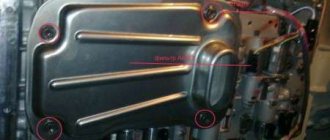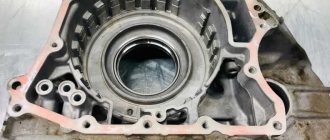Toyota Camry passenger cars with an XV40 body use 5- and 6-speed automatic transmissions, working in conjunction with 2.4 and 3.5 liter engines. Changing the oil in the Camry 40 automatic transmission allows you to remove wear products and normalize the operation of the unit. You can change only part of the fluid yourself. For full service it is necessary to use special equipment.
Transmission sizes on Camry 40
On cars with a 2.4 liter engine, a 5-speed hydromechanical gearbox U250E is used, designed for 8 liters of fluid.
A similar unit is used on cars with a 3.5 liter engine. They are supplied to the American market. During a partial replacement, 2.9 to 3.5 liters of oil are drained from the sump.
In Russia, a modification of the Toyota Camry is offered with a 6-speed U660E transmission and a 3.5-liter V-engine. During partial replacement, up to 3 liters of fluid are drained from the housing; the total capacity of the hydraulic system is 6.57 liters.
How we are working?
The first thing that is necessary when your Toyota Camry XV40 arrives for service is diagnostics. Diagnostics allows you to determine the source of the problem and choose ways to eliminate it. Most often, it is carried out in three ways: using special equipment that reads error information from the on-board computer, then by an on-the-go test drive and, finally, by visual inspection during partial or complete dismantling of the problem unit.
Having determined the cause of the problem, our technicians install the necessary spare parts and work to restore the machine’s functionality, as well as their cost. If you agree to our conditions, the machine is accepted for work. Our technicians promptly eliminate all identified problems. After that, the car is checked once again. Only if no problems are identified in its operation, our employees will hand over to you a fully functional car, which also has a Camry 40 body in perfect technical condition.
Checking the oil level in the automatic transmission
The algorithm for checking the oil level in the crankcase is as follows:
- Warm up the engine and gearbox by driving for a distance of 20-25 km.
- Stop the car, and then move the selector sequentially through all positions, holding the lever in each position for 5 seconds.
- Place the selector handle in position P (park).
- With the engine running, open the engine compartment lid and then pull out the special dipstick with a plastic handle.
- Wipe the rod with a dry cloth or piece of lint-free cotton cloth.
- Insert the dipstick into the guide tube and remove it again.
The inscriptions Cool (cold) and Hot (hot) are applied to the rod, which indicate the permissible liquid level at different temperatures. The upper notch near the Hot marking reflects the amount of liquid when the unit is fully warmed up. The lower mark next to the Cool inscription displays the minimum level on a cold box (at a temperature of 30°C). Based on the condition of the oil on the dipstick, you can determine the degree of degradation of the fluid (for example, if wear particles are detected and a burning smell appears, you need to prepare for a major overhaul of the automatic transmission).
Electrics
There are enough problems here. The overrunning clutch greatly damaged the reputation of the car, living no more than 100 thousand. It causes unnecessary sounds and the attachment belt coming off. Generator brushes last 150,000 km.
The wiring is holding up in an exemplary manner, it does not rot and only the trunk lid harness is frayed. Of course, we remember about the immobilizer problems.
Former owners of stolen sedans are complaining about an open ECU engine block. They exchange it for another and leave. The keys are also easily stitched to fit the model, so it is recommended to remove the diagnostic connector and protect the hood. Stealing a magpie is a matter of two minutes.
Fluid change interval
The manufacturer of the Camry with the XV40 body does not indicate in the service documentation the timing for replacing the fluid in the hydraulic transmission. The instructions contain a recommendation to check the material level every 40 thousand km. By the appearance of the fluid, you can judge the need for automatic transmission maintenance or repair.
Recommendations for replacing fluid in the crankcase of U250E and U660E gearboxes:
- full maintenance is carried out after a mileage of 60 thousand km;
- Partial oil draining is carried out after 30 thousand km.
This technique allows you to remove wear particles from the crankcase and renew the fluid circulating in the hydraulic circuit.
When draining the lubricant, you need to pay attention to its condition. If the transmission is in good condition, the drained fluid may contain sediment. The smell of burning and the presence of foreign particles in the drained material that are formed during the destruction of friction packs or planetary gears are not allowed.
Our advantages
For the owner of a Camry XV40, the modern market offers a wide selection of services that you can contact for repairs and maintenance of this model. Our car service “Engine” guarantees that if you choose us, you will not regret it. Why should you contact Engine? We can give you several reasons:
- We have a decade and a half of experience in the auto repair and maintenance market.
- Our service staff employs only experienced craftsmen who are well versed in the nuances of this particular model.
- We provide all our clients with a guarantee, both for the work performed and for the parts and supplies used during the work.
- The optimal combination of service quality and cost allows you to receive qualified repairs at a competitive price.
- A conscientious attitude and taking into account all the client’s wishes will ensure that any problem is resolved within a time frame convenient to you.
- During repairs, modern equipment from Italy is used, eliminating the slightest errors in operation.
- Having our own spare parts warehouse gives the service the opportunity to eliminate problems for a variety of reasons at any time.
Wise choice of oil
The transmission is equipped with an electronic control unit, which selects the switching moment depending on the pressure in the lines, speed and load.
The controller algorithm is designed to use the original ATF WS composition from Toyota:
- article number of a 4 liter canister 08886-02305;
- metal can with a capacity of 1 liter under code 08886-80807;
- plastic tank with a volume of 1 liter under catalog number 08886-81210.
At the factory, the crankcase is filled with Toyota Type T-IV material (information is indicated on the dipstick handle).
Valid alternatives:
- Toyota ATF WS oil, produced by Exxon Mobil for the US market, is supplied in a 0.946 liter plastic canister under article number 00289-ATFWS;
- the original ATF WS material for Canada is offered under the designation Cobra-WSATF-OL (plastic container with a capacity of 1 liter);
- analogue of Idemitsu ATF Type-TLS-LV, meeting the standards of the Toyota concern (code 10114-042B, plastic jar with a capacity of 1 l);
- analogue of ENEOS Import ATF Model TW, packaged in plastic canisters with a capacity of 0.946 l (code 3107-300, intended for the North American market).
The original liquid is based on a synthetic base. Crystallization occurs when the temperature drops to -44°C.
The material contains components that reduce the wear rate of gears during sudden or frequent switching. The composition complies with the Aisin company standard (automatic transmission developer) JWS 3324 and meets the requirements of the NWS-9638 standard. Compliance must be considered when selecting fluid from alternative suppliers.
Tools and consumables for performing work
To service the box you will need the following consumables:
- Filter for liquid purification. Article number of the original element 35330-08010 (2.4 l) or 35330-33050 (3.5 l). It is possible to use analogues from JS Asakashi or Azumi, differing in cost reduced by 15-20%. A pan seal is supplied along with the cleaning elements. If the seal is not included in the kit or the part is damaged during installation, you must buy a gasket with article number 35168-21020 or 35168-33080 (2.4 and 3.5 l, respectively).
- O-ring 90301-32010. It is installed on the filter neck.
- New drain plug 90341-18016 and metal O-ring 90430-18008 (both from Toyota).
Necessary tools and equipment:
- a set of wrenches or sockets (sizes 10, 17 and 24 mm);
- 6 mm hex key;
- funnel with an installed hose for filling fresh liquid;
- container for collecting waste material;
- rags for wiping;
- gasoline or solvent to clean the pan.
Simple, strict style
The design of the car looks simple, Toyota has never been an innovator in the field of appearance, competitors are more beautiful. There are narrow headlights, directed downwards, equipped with halogen or xenon lamps. The rounded shapes of the Camry's hood flow like lines towards the strict radiator grille, which in the restyling is covered with chrome.
The bumper is equipped with optics washers and fog lights recessed at the bottom. Restyling brought a slightly different bumper with PTF in a chrome trim.
On the side there are powerful massive forms with a slight swelling of the arches. The business-class image is supported by chrome window surrounds and a straight line leading to the rear lights. The rear lights are identical in shape to the front ones. The trunk lid has a raised shape, creating a powerful image together with the massive bumper.
It was the concentration of design on rigor that pleased officials, who are the main consumers of the model. The car looks simple, but is relatively luxurious.
The dimensions of the sedan have grown:
Complete manual oil change in automatic transmission 40
To carry out a complete fluid change in a 6-speed automatic transmission manually, you must:
- Drive the car onto an overpass or into a garage, and then turn the wheels to the left all the way.
- Wait for the fluid in the transmission housing to cool.
- Remove the protection screen and unscrew the drain plug.
- Wait until the oil stops flowing into the substituted container, and then unscrew the plastic plug located in the drain channel.
- Using a 10 mm wrench, unscrew the bolts holding the stamped pan to the automatic transmission housing.
- Remove the casing, which contains 300-400 ml of liquid and magnets for collecting metal dust.
- Unscrew the filter fixing bolts with a 10 mm wrench.
- Place the rubber sealing ring and install the new cleaning element in place.
- Wash the removed casing with gasoline, and then mount the part in place, after installing a new gasket.
- Replace the plugs in the drain hole, and then fill the crankcase with fresh fluid.
- Close contacts 4 and 13 in the diagnostic block with a wire or a special adapter, and then move the selector through all positions with a 5-second delay (with the engine running). Remove the wire and warm the box to 50°C (until the D indicator turns on when the selector is in the parking position).
- Drain excess fluid from the crankcase or add it, then warm it up to 50°C and drain it.
- Tighten the drain plug and install the removed parts.
- Perform a partial oil change after 2-3 days of operation.
Spacious interior comfort
There is a lot of free space inside, passengers sit on cool, soft leather chairs. The front row is electrically adjustable in good trim levels and is heated. The rear may also be heated, and top trim levels even had an 8-degree backrest tilt adjustment.
Inside there is everything you need, from a multimedia screen that supports navigation to separate climate control. There is no point in dwelling on the equipment; it would be better to describe the equipment separately.
Leather is predominantly used as lining, but the manufacturer did not skimp on plastic parts, and added wooden elements for decoration. The leather upholstery of the Toyota Camry 40 after 150 thousand begins to actively lose its presentation. Breaks are rare, but breaks and serious abrasions are common. The power seat adjustment works great, but sometimes the wiring fails.
Plastic elements, including the rear part of the steering wheel, begin to squeak over time. It’s better to do it, otherwise what’s the point of good sound insulation if there is another, internal sound source. By the way, the Shumka field of 200 thousand is no longer so steep, because the seals are worn out. Decorative wooden inserts do not withstand the climate, losing their external varnish.
In addition to the creaking of the plastic steering column, frequent sharp turns interrupt the wiring, causing the steering wheel buttons to fail. Toyota organized a recall company to replace power windows - problems occurred, and they also changed the floor mats, since the driver could press the gas pedal.
Use of special equipment
When servicing the box in a service center, it is necessary to disconnect the hoses from the oil cooler. One line is connected to the pumping station, and the second is discharged into a reservoir for collecting waste. The pump forces fresh fluid into the crankcase until clear red oil begins to flow out. The advantage of the technique is the complete displacement of waste material from the crankcase.
It should be borne in mind that fresh fluid washes away deposits of wear products that enter the hydraulic system and clog channels and valves. There may be jerks or pauses during shifting, accompanied by a change in the crankshaft speed. To restore functionality, you will need to disassemble the unit and flush the hydraulic unit. The increased volume of liquid used when flushing should also be taken into account (50-70% more than the nominal capacity of the crankcase).











